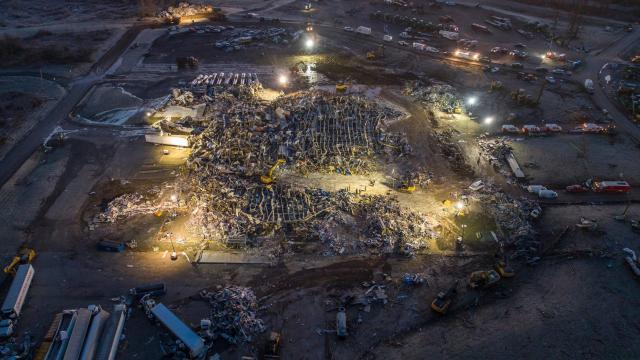Deadly tornadoes swept through six states and killed at least 80 people this weekend. Among the dead are at least 14 workers in two states who died after the storm ripped apart a candle factory and Amazon warehouse.
Understanding exactly how and why these workers lost their lives will take time as investigators sift through the rubble. But there are ample guidelines for how to protect workers when violent weather hits, guidelines that initial reporting indicates may not have been followed.
Eight people died while working an overnight shift at a candle factory in Kentucky. Workers at the factory told NBC News that they were told they couldn’t leave or they would be fired. The company, Mayfield Consumer Products, denies those claims and, in addition, told the AP that the company held regular emergency drills and that employees went to an internal shelter when the storm began. The strength of the storm, the spokesperson said, was just too strong for the building to withstand. But Bryanna Travis and Jarred Holmes, an engaged couple who had both been working at the factory for several months at $US14.50 ($20) an hour, told the AP a different story. “We haven’t had [a safety drill] since we’ve been there,” Holmes, who was not at the factory when the storm hit, said.
Initial reporting from the Amazon warehouse in Edwardsville, Illinois, where the tornado killed six workers and ripped off the building’s roof, is unclear on whether workers were adequately notified of the tornado and how secure the onsite shelter was. At least one worker killed there reportedly wasn’t allowed to leave. Workers have also said they don’t have access to their phones on the warehouse floor, phones that blast out emergency alerts about tornado warnings. (We’ve reached out to Amazon with several questions about disaster preparedness and worker safety at its warehouses, and will update this piece if we hear back.)
While Friday’s storm system spawned particularly violent tornadoes, there are well-known, basic strategies to keep workers at large facilities safe when twisters hit. Last year, the American Meteorological Society put out a detailed guideline of best practices for large retail outlets like Home Depot and Walmart — brands that have many buildings structurally akin to warehouses and factories — during severe wind events like hurricanes and tornadoes. The document’s main emphasis is on preparation, planning, and communication with staff, including developing a severe weather plan, tasking a point person with monitoring serious weather, and ensuring all employees know their role in executing an emergency plan. Being ready is of utmost importance when severe weather is on the horizon.
“The window for decision-making is short once a tornado is spotted,” Carol Cwiak, an associate professor at the Department of Emergency Management and Disaster Science at North Dakota State University, wrote in an email. “Plans and decisions made under that stress and in that abbreviated time frame may not be the most effective. Hence, the need for all businesses to plan and prepare before such an event.”
However, there are a lot of ways that American businesses operate right now that cut out crucial parts of this process — most notably, reliance on part-time laborers and contractors, who may not be in the loop with plans as much as full-time employees. Mayfield, the AP reported, had just put out a call on Facebook for new hires during the holiday rush. A source told the New York Times that just seven of the nearly 200 workers at the Amazon warehouse that day were actually employed by the company; the rest were contractors, who, a spokesperson confirmed to the Times, were not required to check-in each day. First responders said this lack of an official tally of people inside the warehouse made getting an initial headcount when they arrived on the scene difficult.
Even if a business does have an area for employees to safely shelter, the physical aspects of traditional factories and warehouses may not be designed to protect workers as extreme weather worsens — which makes regular communication with employees about a disaster scenario even more important. One expert speaking to the AP pointed to the Mayfield factory layout — long hallways set up for line work, no basement — as particularly vulnerable during a tornado or storm. Local authorities in Illinois also confirmed that the Amazon fulfillment centre had no basement where workers could take shelter.
Cwiak agreed with that assessment.
“Here is the thing,” she wrote. “If a business knows they have inadequate shelter for such an event, they need to be prepared to either identify and procure (in advance) a close suitable shelter location or close down operations and let workers go home until the threat is no longer present. Businesses have an obligation (a duty of care) to their employees and patrons regarding the risks and hazards that they are aware of or should be aware of — period, full stop. There is no room for excuses in this space when folks are injured or die because a business didn’t meet its duty of care burden.”
It’s not just tornadoes that factories and warehouses will need to account for. A warming world will also unleash more floods, heat waves, and fires. Amazon has already faced criticism multiple times this year for how it treats its employees during extreme weather, including having warehouse workers come to their shifts even as the remnants of Hurricane Ida drowned New York and not providing air conditioning in some of its warehouses during heat waves.
The company has been building new structures at a breakneck pace over the past few years. More than 500 delivery stations like the one destroyed in Illinois have been opened since 2017, of which 300 have been constructed in the past year alone. That points to a need for more holistic solutions, whether it is adequate cooling or time off work during dangerous weather, that meet that “care burden” Cwiak mentioned.
